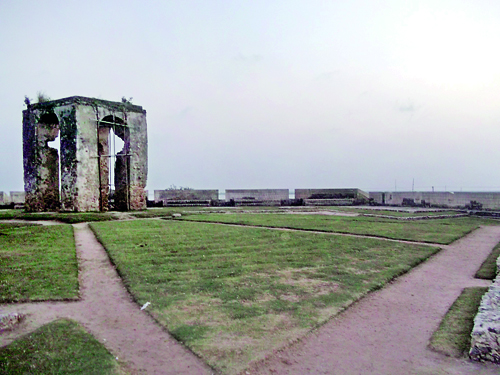The lost towns of Taprobane’s north
View(s):I come to the northern capital as a casual visitor or a curious stranger and even a concerned interloper. I’m among those who have been missing (by default, not design) in the intervening years; those of conflict and trauma and a succession of tragic losses. If ever war ravaged the face of a township, this ancient citadel is that forlorn place. The craters have been filled for almost five years now. And the scars that pockmarked its twisted visage have been plastered over for a while since then. But the wounds of internecine variance and warfare are not easily washed out by the salt of an erstwhile enemy’s cold-handed kindness.
 It is a sad town… a lost city: a Xanadu, or a Shangrila, or an El Dorado; and – although hardly a Utopia – it has the potential to become a Newtopia. There is a sense of being lost amidst the many-faceted spires of development beginning to spring up, if not tower above, lonely stretches of as-yet-uncleared unexploded ordnance. There are still signposts, so near the roadside, which are the legacy of travellers along such different, indifferent routes to ambitious armed men’s vainglory.
It is a sad town… a lost city: a Xanadu, or a Shangrila, or an El Dorado; and – although hardly a Utopia – it has the potential to become a Newtopia. There is a sense of being lost amidst the many-faceted spires of development beginning to spring up, if not tower above, lonely stretches of as-yet-uncleared unexploded ordnance. There are still signposts, so near the roadside, which are the legacy of travellers along such different, indifferent routes to ambitious armed men’s vainglory.
In the heart of the town that gives its identity to the eponymous peninsula, the familiar landmarks stand silent testimony to Jaffna’s historic legacy. These are interspersed by new monuments that bear mute witness of the colonial (as well as neo- and postcolonial influences) which have shaped the new city’s emerging sense of character – if not purpose. The Old Dutch Fort, now renewed by courtesy of the state and generous grants from the government of the Netherlands; the New Park; the New Public Library to replace the Old Public Library by dint of its visibility… even if – by virtue of its demise and destruction – the older building is irreplaceable in the national imagination. As a symbol of both the academic vigour of its native sons and the acerbic vulgarity of other sons of the soil who burnt it down… not so many moons ago – that such pointless vandalism would be forgotten. If ever…
The mood must lighten, for the sake of town and country. And it has in certain quarters and to some measure of its former vibrancy. The best-known establishments are back in business. The city centre and outlying marketplaces are both thriving hubs of trade and commerce. The ubiquitous demure Jaffna girl on a bicycle modestly making her way from family home to friend’s house has been

An abandoned belfry on the uppermost level of the Dutch Fort rings out a hollow peal of an ancient monument that has lost its appeal for many
overtaken by a more dashing (albeit daring) maiden. She is now on a motorcycle, and cares little for road rules – by the looks of it! And even less for Colombo motorists by the sounds of the swearing that local drivers and (more so) surprised southern chauffeurs have good cause to resort to at so many near-misses!
Army and naval stalwarts now take up the slack yielded to the victor by a lost generation of youth missing in action or inaction. They fill the void and the vacuum with the vim, and the vigour, and the vitality that can only come as a natural consequence of being the victor in a bitter and protracted battle between and among regimented, rebellious, and reactionary forces. They run small businesses on the coastline’s most beautiful beaches; man and maintain wayside refreshment kiosks and supermarkets alike; and operate near-star-class hostelries, restaurants, and hotels. They also safeguard the land in general and the peninsula’s many islands in particular and the sundry causeways linking them from the ever-present spectre of secessionism.
There is in this strange and antique peninsula a challenging dichotomy between soured despair and resurgent hopefulness. On the one hand, a certain vacuity in the eyes of some of the citizens of this vale of tears speaks volumes of loss, inner wounds, and absence of abundant life. On the other, this listlessness is matched by a keen sense of industry among at least the fortunate few who have not been permanently scarred or discarded by the vagaries of war. These serve self-interest, state interests, and interested southerners who visit well – though not necessarily in that order, and not each of the three elements all the time.
In some places, the public is well served by an insistence on propriety. “This is a place where people eat. Remember to behave with dignity and decorum.” “Keep this space clean and tidy at all times.” In others, existing signage is honoured more in the breach than the observance. “The use of fealty words will be fined.” (One takes it they mean ‘filthy’ or swear-words that violate the venerable sacro-sanctity of well-known venues such as Nallur Kandasamy Kovil or lesser-known little-promoted places like the mineral springs of Keerimalai.) In a few, there is an opportunity cost – and an attendant loss of revenue to state coffers? – by dint of there being no information. The Dutch Fort is a prime example of a tourist attraction left lying idle, unattended, and unappreciated in the balmy sun of apathy and indifference. The forgotten Archaeological Museum, housed in a makeshift thatched hut at best, is another. It is a repository of riches that foreigners and friends of Sri Lanka alike would pay top-dollar to experience – if properly curated and promoted. In contrast, busloads of travellers throng to Kandurodai (or Kanduragoda) and flock around sacred sites such as the place where the Enlightened One ostensibly set foot on Jaffna’s shores.
In the limit, it is a town still caught in a sort of limbo – or, perhaps more accurately, purgatory. We pray for it and wish for ourselves that the penance it has to pay for its previous (but by now past and forgiven presumption) will be short and relatively painless. The reassuring fact that the railway line shows every sign of crossing over Elephant Pass and into the once-forsaken northern towns of the peninsula brings with it some hope and the promise of integration with national life in the rest of the island.


